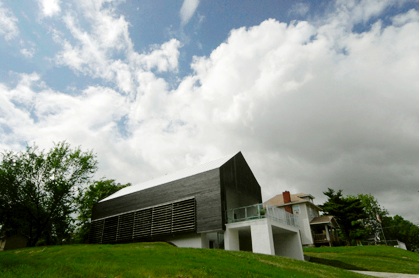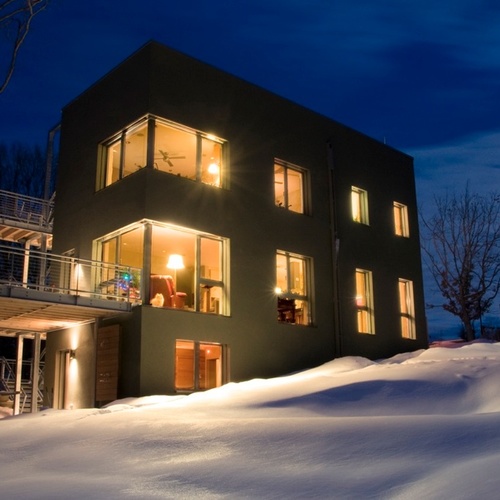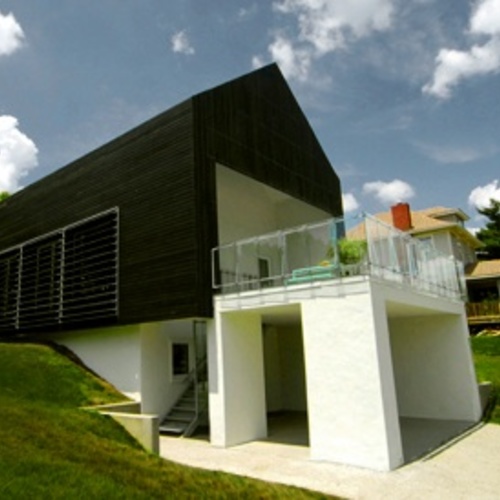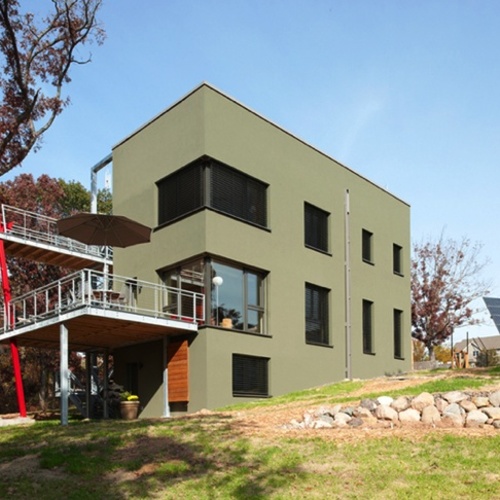Image Credit: Studio 804
Image Credit: Studio 804 A project of the Studio 804 design-build program at the University of Kansas School of Architecture and Urban Planning, Prescott Passive House has had trouble attracting buyers, according to Dan Rockhill, a professor at the school. Prescott Passive House has 1,700 sq. ft. of interior space.
In many city neighborhoods, an attractive three-bedroom, two-bath house with 1,700 sq. ft. of living space and construction quality that brings it to Passive House standards would seem like a pretty swell deal if it listed for $190,000.
But as Dan Rockhill, a professor at the University of Kansas School of Architecture and Urban Planning, recently pointed out to USA Today Green House columnist Wendy Koch, in Kansas City, Kansas, code-built new homes of comparable size sell in the $140,000 range. The price disparity and current economic conditions, Rockhill says, have deflected buyer interest from the recently completed Prescott Passive House, the fifteenth project undertaken by the school’s Studio 804 design-build program. It is, in fact, the 1,700-sq.-ft., house described above – the beneficiary of much free student labor and corporate generosity, and the first residence in the state designed and built to qualify for Passive House certification. But its energy efficiency performance and durable construction don’t seem potent enough to attract a buyer will to pay its $190,000 price.
The situation is especially troubling, Rockhill says, because of its implications for Studio 804, whose projects have sold readily in the past but must continue to do so to perpetuate the program. Studio 804, which gets no university funding, now has $25 in its checking account and is “essentially bankrupt,” he told USA Today.
Reader back and forth
Both Koch and Treehugger columnist Lloyd Alter, an associate professor of sustainable design at Ryerson University in Toronto, acknowledge that, in many markets at least, buyers still are far less likely to pay more for energy efficiency than they are for amenities they can see and touch the instant they walk into the house, such as high-end countertops and other finishes.
Some Treehugger readers who say they’re familiar with Studio 804 and/or have visited Prescott Passive House commented that imperfections in its finish work and its inner-city neighborhood may make it difficult to sell to prospective buyers shopping in the $200,000 price range.
But in a recent Treehugger post, Alter takes time to refute comments by Green House readers who complain generally that the design, materials, appliances, and construction techniques that go into high-performance homes don’t justify the up-charges.
“The fact is,” Alter writes, “you can’t build R-50 walls for the same price as R-20. You can’t put in a Passivhaus-sized heat recovery ventilator for the price of a bathroom exhaust fan. You can’t get rid of vinyl siding and windows and formaldehyde and asphalt shingles without paying more. And even if you could do all of this, you can’t build a single house to these standards, compared to the American house production line, in a field where it is slapped together by itinerant workers getting paid half of what they did two years ago because the construction industry has collapsed.”
Weekly Newsletter
Get building science and energy efficiency advice, plus special offers, in your inbox.
















11 Comments
Creativity Needed To Sell This Home
I applaud the work of the 804 team. The interior photo reminds me of the featured home that I visited in Dresden at this year's Passiv Haus conference. I relate to the challenge of selling the Passive House for more than the code built (worst construction allowed by law) homes. I have been renovating homes to high levels of energy efficiency and selling them for about 20% above the rest of the neighborhood. When we've wound up with a home that wont sell or wont appraise we've had to get creative. We've used Lease-Options, Rent To Own, and other techniques. All homes are now sold or leased. The worst thing is to leave them sitting vacant. I'm willing to brainstorm with leadership on getting this fine home sold so you can start working on the next one.... Dave Robinson, Principal, Green Earth Equities. President, California Building Performance Contractors Association
Vocabulary
Refute - transitive verb - to disprove. Alter does not refute the argument that a house built to Passivhaus standards is more expensive than a conventional house with equivalent living space and features. Rather, he admits that it is inevitably going to cost more. Unless and until the whole-cycle costs of ownership appear in the monthly bills it is going to be an impossibly hard sell to persuade people to improve the performance of their houses on the basis of cost.
What is needed is a sizeable market of people with generous capital and low income. Perhaps targeting down-sizing retirees would be a way to get more high-performance buildings out there. Let's face it folks - the preference of the majority for houses that look conventional will always make this job difficult. Why pay more (or accept a poorer standard of finish or fittings) for a house that looks like the one next to it when the only difference is a reduction in running costs? That's easy - you get to pay a higher mortgage which destroys the improvement in running costs until it is finally paid off leaving you with a house you can't sell for what you paid for it. The bottom line is the bottom line for so many people, mostly from necessity rather than choice, that trying to sell high-performance buildings on the basis of cost is a sure way to finish with 25 dollars in your checking account. For the vast majority of people the house shown in Image one would not be described as attractive. Perhaps the green building movement needs to learn that 90% adoption of 10% improvement is more achievable, and does far more good, than less than 1% adoption of 90% improvement.
median home value
The median home value for the zip code is $66,500 and the median household income is $33,000. It's probably difficult for this house to compete, even though it is high quality new construction. Or maybe it's difficult for any high quality new construction to compete in this neighborhood.
It would be interesting to see what the upcharges were for the Passive House features and for the LEED Platinum features. I suspect it would be less than 10% of construction costs and that this house would still have a long time on the market at $180,000.
price of PH
There is no question: a difference of $60.000 is far to much, can't be justified just by using a green label. That's not the basic idea behind the passive house. The cost differences in Europe are in the range of some €12.000, and work is going on to reduce this. Yes, there are "learning costs", such we faced in Germany, too - the very first passive house was some €45.000 more expensive than "ordinary new buildings" - but that was a prototype, no components available on the market, all custom made windows, ventilation system, control ... in 1990. That's why we started research on "cost efficient passive houses" in 1996. And the results have been published - made freely available in the papers (most in German) and now to come on http://www.PassPedia.org , too (in English translation).
price of PH
Sorry, the link in my last post does not work. Take this one:
http://passipedia.passiv.de/passipedia_en/
Passive house
I don't find the price off-putting. I might find the neighborhood off-putting, though I know nothing about it. What I do see as a problem is that the style of the house does not fit in with the neighborhood.
Incremental costs
As a Passive House designer/builder I can offer potential encouragement to those trying to justify these higher up-front costs – clearly the main impediment to increased acceptance of this standard. We’re about to begin construction of E.Canada’s first Certified Passive House, and my client, naturally enough, has real concerns about cost and payback on her new 1550 sq.ft detached home. My calculations show an added incremental cost of around $20k, and modeling indicates an 88% annual energy saving, so at her current interest and electric heating rates she would actually be marginally ahead on a monthly basis with a Passive House from year one (i.e. monthly savings of $110 vs. increased mortgage cost of $95), as compared with a Code unit.
Of course a sample (as yet unbuilt) of one proves nothing, and local building costs are notoriously variable, but even if our incremental costs prove higher we should still demonstrate that an energy saving of around 90% is achievable today for a 10% increase in construction cost (assuming no grants or assistance).
Depending on how that is financed we hope to show that in our severe climate a Passive House can be the cheapest house overall – and of course the most durable, healthy and comfortable – not in some distant epoch but from year one, today. As for her neighbour’s $12k Corian countertop, I’ve yet to figure out the payback.
Builders and remodelers
Builders and remodelers everywhere know that selling on the basis of reduced energy costs is difficult because in most places, and in most individual situations, energy costs are not high enough to cause the consumer a lot of discomfort. A small segment of the building industry--those that are able to build a low-energy house--are moving ahead of the market for the time being, but will probably find that escalating energy costs push their expertise and products into the limelight at some point in the near future, and probably fairly suddenly.
It sounds like the builders of the home in this article made a few mistakes, location being the main one. "Imperfections in the finish work" also do not help. These things aside, I commend them for their efforts and wish I could find the capital to do the same here.
Actual cost of the house
"...the beneficiary of much free student labor and corporate generosity..."
So how much more than the $190k sticker price would this house have cost without the discounted effort and hardware ?
problem is the style of the house
Previous poster hit the nail on the head. House is ugly and does not fit in with the neighborhood. How who would you like to be the homeowners on either side of this POS when they try to sell their house? How much of a hit are they going to take on their resale value? This looks like a school project that should never have seen the light of day.
Maybe the professor should have followed their example
“We wanted our house to fit in with the surrounding neighborhood and Nathan really made that happen,” https://www.greenbuildingadvisor.com/blogs/dept/green-building-news/traditional-styling-passive-house-construction
Log in or create an account to post a comment.
Sign up Log in